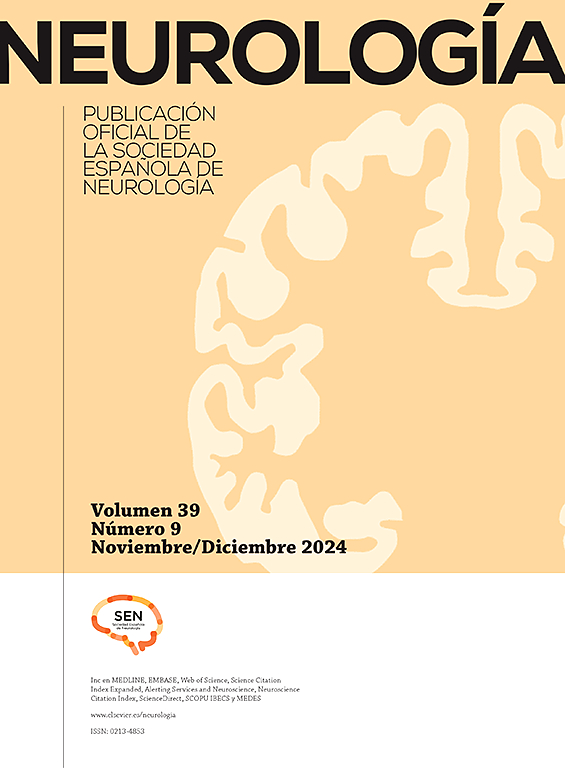Selección de pacientes para cierre percutáneo en el ictus isquémico no lacunar criptogénico asociado a foramen oval permeable. Datos del registro cooperativo NORDICTUS
IF 3.1
4区 医学
Q2 CLINICAL NEUROLOGY
引用次数: 0
Abstract
Introduction
There is an extending use of percutaneous closure of patent foramen ovale (PFO) as therapy for PFO-associated cryptogenic strokes. The aim of our study was to investigate the clinical practice of percutaneous closure of PFO and to analyse the variables for decision-making on the selection of patients for this procedure.
Method
A prospective observational multicentric survey was conducted using all the cases of cryptogenic stroke/transient ischemic attack associated with PFO recorded in the NORDICTUS hospital registry during the period 2018-2021. Clinical data, radiological patterns, echocardiogram data and factors related to PFO-associated stroke (thromboembolic disease and paradoxical embolism criteria) were recorded. The indication for closure was analysed according to age (≤/ > 60 years) and the characteristics of the PFO.
Results
In the group ≤60 years (n = 488), 143 patients (29.3%) underwent PFO closure. The most influential variables for this therapy were detection of a high-risk PFO (OR 4,11; IC 2,6-6,5, p< 0,001), criteria for paradoxical embolism (OR 2,61; IC 1,28-5,28; p = 0,008) and previous use of antithrombotics (OR 2,67; IC 1,38-5,18; p = 0,009). In the group >60 years old (n = 124), 24 patients had PFO closure (19%). The variables related to this option were history of pulmonary thromboembolism, predisposition to thromboembolic disease, paradoxical embolism criteria and high-risk PFO.
Conclusions
The detection of a high-risk PFO (large shunt, shunt with associated aneurysm) is the main criterion for a percutaneous closure-based therapy. Other conditions to consider in the eligibility of patients are the history of thromboembolic disease, paradoxical embolism criteria or the previous use of antithrombotics.
隐源性非间隙缺血性中风伴可通透性椭圆形孔经皮闭塞患者的选择。NORDICTUS合作注册数据
经皮卵圆孔未闭封闭术(PFO)作为治疗PFO相关隐源性卒中的应用越来越广泛。本研究的目的是探讨经皮PFO闭合术的临床实践,并分析选择该手术患者的决策变量。方法对2018-2021年nordicus医院登记的所有与PFO相关的隐源性卒中/短暂性脑缺血发作病例进行前瞻性多中心观察性调查。记录pfo相关卒中的临床资料、放射学模式、超声心动图资料和相关因素(血栓栓塞性疾病和矛盾栓塞标准)。按年龄(≤/ >;60年)和PFO的特点。结果≤60岁组(n = 488), 143例(29.3%)患者行PFO闭合术。对该疗法影响最大的变量是高风险PFO的检测(OR 4,11;IC 2,6-6,5, p<;001),矛盾栓塞的标准(OR 2,61;集成电路1 28-5 28;p = 0.008)和既往使用抗血栓药物(OR 2,67;集成电路1 38-5 18;p = 0.009)。在60岁组(n = 124)中,24例(19%)患者有PFO闭合。与此选项相关的变量是肺血栓栓塞史、血栓栓塞性疾病易感性、矛盾的栓塞标准和高风险PFO。结论高风险PFO(大型分流器,分流器伴动脉瘤)的检测是经皮闭合治疗的主要标准。在患者资格中需要考虑的其他条件是血栓栓塞性疾病史,矛盾的栓塞标准或以前使用抗血栓药物。
本文章由计算机程序翻译,如有差异,请以英文原文为准。
求助全文
约1分钟内获得全文
求助全文
来源期刊

Neurologia
医学-临床神经学
CiteScore
5.90
自引率
2.60%
发文量
135
审稿时长
48 days
期刊介绍:
Neurología es la revista oficial de la Sociedad Española de Neurología y publica, desde 1986 contribuciones científicas en el campo de la neurología clínica y experimental. Los contenidos de Neurología abarcan desde la neuroepidemiología, la clínica neurológica, la gestión y asistencia neurológica y la terapéutica, a la investigación básica en neurociencias aplicada a la neurología. Las áreas temáticas de la revistas incluyen la neurologia infantil, la neuropsicología, la neurorehabilitación y la neurogeriatría. Los artículos publicados en Neurología siguen un proceso de revisión por doble ciego a fin de que los trabajos sean seleccionados atendiendo a su calidad, originalidad e interés y así estén sometidos a un proceso de mejora. El formato de artículos incluye Editoriales, Originales, Revisiones y Cartas al Editor, Neurología es el vehículo de información científica de reconocida calidad en profesionales interesados en la neurología que utilizan el español, como demuestra su inclusión en los más prestigiosos y selectivos índices bibliográficos del mundo.
 求助内容:
求助内容: 应助结果提醒方式:
应助结果提醒方式:


